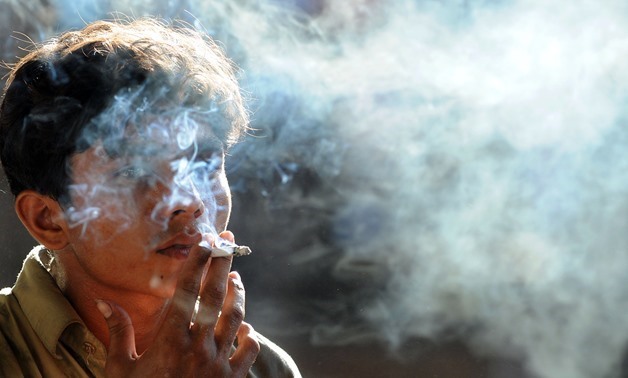
FILE - Water pipes known as shishas are popular in cafes, where smoking restrictions don’t apply,
CAIRO – 30 June 2018: One hundred and eighty million men are predicted to be smoking in the Middle East and Africa by 2025, twice as many as 2000’s 90 million, according to Bloomberg. Of those, many are Egyptians: Almost 12.6 million Egyptians are smokers, making up 20.2 percent of the total population, according to Central Agency for Public Mobilization and Statistics (CAPMAS).
As tobacco use steadily and regularly decreases around the world due to rising prices, as a result of taxes, rigid regulations on tobacco companies and banning the marketing and advertising of tobacco products, the Middle East and Africa continues to be an anomaly. In fact, research has found that smokers are quickly on the rise in low- and middle-income countries on a global scale, and even more so in the Middle East and Africa due to weak, and sometime, non-existent, regulations and control measures.
According to CAPMAS 2015 survey linking smoking to income, expenditure and consumption, 23 million Egyptians are exposed to negative smoking, half of which are females. Moreover, 41.2 percent of employers smoke, and the average annual expenditure of an Egyptian household on smoking is LE 1,722 ($95.14).
“Egypt alone has seen its smoker population nearly double since 2000, reaching around 14.4 mn today. Water pipes known as shishas are popular in cafes, where smoking restrictions don’t apply,” according to Bloomberg.
 Taxation continues to be the least used strategy worldwide.
Taxation continues to be the least used strategy worldwide.
Aligned with these findings, the Shares of Easter Tobacco in Egypt, which holds a monopoly on cigarette production in Egypt, have hit successive record highs with a significant 161 percent increase in shares in the first half of 2018.
Although Khaled Sadek, head of consumer and healthcare research at CI Capital, believes that this increase is due to a rise in prices, evidence does suggest that this increase also comes as a result of an increase of number of users.
“They raised their ex-factory prices by about 40 percent compared to last year and they still have a big part of their inventory of raw tobacco from before the currency float which makes the cost low for them and the margins higher,” explains Sadek.
“Tobacco is marketed mainly to men [in the Middle East and Africa]. To reverse this [the rise of smokers in the region], governments need to more firmly confront the tobacco industry’s efforts to recruit the next generation of smokers,” recommend Bloomberg’s editors.
Agreeing with this Enterprise writes, “Tobacco companies in the Middle East and Africa need to be slapped with more taxes, restrictions.”
 Egypt alone has seen its smoker population nearly double since 2000, reaching around 14.4 mn today.
Cracking down on smoking
Egypt alone has seen its smoker population nearly double since 2000, reaching around 14.4 mn today.
Cracking down on smoking
Experts have found that the most cost-effective and high impact move that leads to a decline in smokers are: raising tobacco taxes, abiding tobacco companies to print graphic health warnings on cigarette packs, banning tobacco advertisements and imposing laws that ban smoking in public areas.
Supporting this view, The World Bank has repeatedly advised of the importance of taxation, expressing its positive impact on decreasing the number of smokers; the Bank has actively worked on declining smokers by partners up with the World Health Organizations (WHO). Despite this, taxation continues to be the least used strategy worldwide.
Yet, not everyone agrees that an increase in prices leads to smokers quitting. “Historically, people don’t stop smoking,” Ahmed Hafez, the co-head of research at HC Brokerage in Cairo, tells Bloomberg, “What happens usually is that they cut the number of cigarettes they smoke per day, and then they usually divert to the normal habits again. But we haven’t seen a prolonged impact on demand since price increases.”
 Enterprise writes, “Tobacco companies in the Middle East and Africa need to be slapped with more taxes, restrictions.”
Egypt takes action
Enterprise writes, “Tobacco companies in the Middle East and Africa need to be slapped with more taxes, restrictions.”
Egypt takes action
To crack down on tobacco use, the Egyptian government, in July 2014, increased the retail prices of cigarettes, to cost about LE 1 more per pack, following an increase in cigarette taxes.
Another 50 percent increase followed in February 2015, and in 2016, prices hiked by another 10 percent.
During 2018, as a way to raise its revenues and tackle smoking, raised taxes once more, leading the government to expect to raise LE 7.072 billion ($402 million) in the 2018-19 draft budget in revenues from this tax, a government document said.
Egypt targets collecting LE 58.524 billion ($3.33 billion) in revenues from tobacco taxes, according to the Ministry of Finance; it is expected that tobacco taxes will come to LE 51.452 billion ($2.93 billion) during this financial year, ending at the end of June.



Comments
Leave a Comment